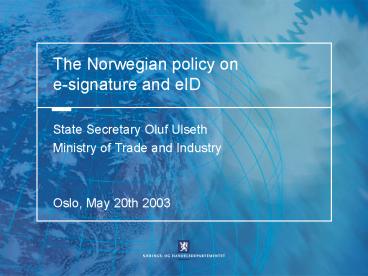The Norwegian policy on esignature and eID - PowerPoint PPT Presentation
1 / 16
Title:
The Norwegian policy on esignature and eID
Description:
The Norwegian policy on. e-signature and eID. State ... Deep technology. penetration. High user. pick-up. Focused. policy targets. 75% have internet access ... – PowerPoint PPT presentation
Number of Views:18
Avg rating:3.0/5.0
Title: The Norwegian policy on esignature and eID
1
The Norwegian policy on e-signature and eID
- State Secretary Oluf Ulseth
- Ministry of Trade and Industry
- Oslo, May 20th 2003
2
Growing economy with need for higher growth in
non-petroleum industries
- Strong economy
- Significant budget surplus
- Low inflation
- Internationally oriented
- Small open economy
- Growth in the non-oil economy
- Knowledge based industries
- Increased RD spending
Export as of GDP
47
The petroleum sectors share of state income
33
3
Low barriers to new technology...
5
4
supported by public policy eNorway 2005
http//www.eNorge.org
5
eNorway 2005 sets out goals.
- Reaching targets of ..
- Creating value for industry
- Efficiency and quality in the public sector
- Involvement and identity
- .. through
- attractive content
- accessibility and security
- skills for change
- a good framework for eNorway
6
with a focused strategy for use of IT
Deep technology penetration
Focused policy targets
- 75 have internet access
- 65 use internet regularly
- 83 use mobile phones
Execution and new goals
- Deployment of PKI
- Availibility and reuse
- of public information
- Standards and prices
- Electronic reporting by
- companies to
- government agencies
- Knowledge management
- eHealth
High user pick-up
- 1,7 m online banking clients
- 1,1 m tax returns delivered
- electronically
7
Transforming (a large) public sector
An efficient and high quality service provider
- Re-engineering to simplify and improve
- Develop public service offices and e-government
- Better co-ordination of benefits related to
employment, social security and social services - Developing tailor-made services to meet
individual needs - Increase the freedom to choose
- More flexible and user-oriented organisations
- A more efficient public sector
- Splitting up demand and supply functions
- Opening up for competing service providers
- More delegation and decentralisation
8
People are worried..
56 of Internet users are unsure or think the
security is not good enough
(Sept. 2002)
9
.. and there are limits
10
Securing appropriate infrastructure
- Stronger competition in the telecom market
- Broadband services will be a driving force for
many applications - Security and trust essential for electronic
information exchange
11
supported by a National PKI Forum vision
- a generally accessible infrastructure for
electronic ID and electronic signature based on
PKI-technology that will enable authentication,
digital signing and confidentiality protection of
electronic communications, and thus support the
goal of increased productivity and
competitiveness of the Norwegian society
12
The electronic signature infrastructure...
Certificate owner
Certificate user (online service)
Certificate issuer
Certificate verifier
Supervising authority
Certificate factory
13
with opportunities and challenges
- Norway is a small country with several success
stories for technology coordination the
girosystem, EFTPOS-terminals, ATMs, and most
recently - eBilling - The authentication services should primarily be
the lubricant, not a business in itself - They must be easy to use and they must be
sufficiently secure for most applications - The PIN storm creates a barrier to online
services - We need not only authentication, but also
signature function and encryption of sensitive
business information the infrastructure might
provide this
14
and strategy
- We shall develop an infrastructure for electronic
ID and electronic signature - The infrastructure shall be market-based and
ensure interoperability and traffic exchange. - The infrastructure shall be put in place in a
cooperation between the public sector and the
private sector - The infrastructure shall be in place and taken
into use by sufficient number of service
providers and end-users by the end of 2005.
15
A working regulatory framework
- Law on electronic signatures since July 01
- Obstacles to electronic communication removed
from the legislation by January 02 - Regulation on electronic communication with and
within the government since July 02
16
A key to growth
- The government supports PKI / eID on many levels
- Coordinate public sector demand
- Facilitate market-driven processes for
interoperability and traffic exchange among
service providers - Create public-private partnerships to develop
innovative solutions - Create project clusters and encourage reuse of
existing infrastructure in order to reduce
societys investment costs































